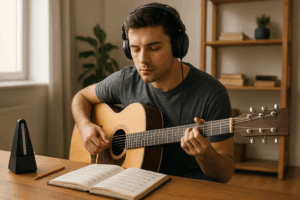One of the most admired musical skills is the ability to play by ear — to hear a song and then reproduce it without needing sheet music. It might seem like magic, but it’s actually a skill that can be learned and practiced, just like reading music or playing scales. For beginners, learning to play by ear opens up a more intuitive and creative connection with music.
In this guide, we’ll break down what it means to play by ear and share practical, beginner-friendly tips to help you develop this powerful ability.
What Does “Playing by Ear” Mean?
Playing by ear means being able to hear a melody, chord progression, or rhythm and then play it on your instrument without relying on written music or formal instruction.
It involves:
- Listening closely to music
- Recognizing notes, intervals, and chords
- Matching what you hear with your instrument
- Using trial and error to find the right sounds
Even if you’re just starting out, your ears are already more musical than you think. With a little training, you’ll be amazed at how quickly you can pick up melodies and play them back.
Why Learn to Play by Ear?
- Boosts Creativity: You’ll start to improvise and create your own melodies.
- Improves Memory: You’ll remember songs more easily because you’re engaging your ears and mind.
- Builds Confidence: You’ll feel more independent and able to explore music freely.
- Helps with Songwriting: You can build chord progressions and melodies by feel, not just theory.
- Great for Jam Sessions: You can join in with others even if you don’t know the song.
Step-by-Step Guide: How to Start Playing by Ear
1. Start with Familiar Songs
Pick a song you know really well — ideally something simple and melodic. Nursery rhymes, old folk tunes, or pop songs with clear melodies are perfect.
Examples:
- “Twinkle Twinkle Little Star”
- “Let It Be” by The Beatles
- “Happy Birthday”
2. Sing the Melody First
Before touching your instrument, try singing or humming the melody. This connects your ear to your voice, which helps with internalizing pitch and rhythm.
Tip: Don’t worry about sounding perfect — the goal is awareness, not performance.
3. Find the First Note
Try to match the first note of the melody on your instrument. Sing the note, then play notes until you find the one that matches.
If you play piano or guitar, this can be done by trial and error until you find the right pitch.
4. Move Through the Melody Slowly
Once you have the first note, try to figure out the next one. Ask yourself:
- Did the melody go up or down?
- Was it a small or big jump?
- Did the note repeat?
This helps you begin to recognize intervals — the distance between two notes.
5. Play It in Small Sections
Work on the song in short phrases. For example:
- First two notes → practice until solid
- Add third note → practice that phrase
- Keep building until you can play the full melody
This approach builds both memory and ear-hand coordination.
6. Use a Piano or Keyboard to Visualize Notes
Even if you’re not learning piano, a keyboard is helpful for seeing the relationship between notes and hearing them clearly.
Tip: Use a virtual piano app if you don’t have a keyboard at home.
7. Practice with Slow-Down Apps
Apps like Anytune or Amazing Slow Downer let you slow down songs without changing the pitch, so you can hear the melody more clearly.
You can loop tricky sections and gradually speed up as you improve.
8. Learn to Recognize Intervals
Intervals are key to playing by ear. Start with simple ones:
- Minor 2nd – “Jaws” theme
- Major 2nd – “Happy Birthday”
- Perfect 4th – “Here Comes the Bride”
- Perfect 5th – “Twinkle Twinkle Little Star”
With practice, you’ll start hearing these distances naturally.
9. Transcribe Music by Ear
Pick a short song and try to write down the notes or chord changes as you figure them out. This builds memory, recognition, and musical vocabulary.
You don’t have to use formal notation — you can just jot down letters or chord names.
10. Practice Every Day
Even 5–10 minutes a day of focused listening and playing by ear can lead to big improvements over time. Make it part of your regular routine.
Tools That Help with Playing by Ear
- Tuned instrument: Keep your instrument in tune so your ear learns the correct pitches.
- Slow-down apps: Great for isolating melodies.
- Ear training apps: Tools like Perfect Ear, Tenuto, and Functional Ear Trainer help you develop pitch recognition.
- YouTube tutorials: Look for play-by-ear walkthroughs of easy songs.
Common Challenges (and How to Overcome Them)
- “I can’t hear the notes clearly.” → Start with very slow, simple melodies.
- “I get lost halfway through.” → Break the melody into smaller sections.
- “I can’t match the pitch.” → Use a tuner or keyboard to check your accuracy.
- “I don’t know what chords to play.” → Start with melodies first, then move to chords.
Final Thoughts: Trust Your Ears and Keep Exploring
Learning to play by ear may seem hard at first, but it’s one of the most rewarding musical skills you can develop. It strengthens your connection to music and helps you express yourself more naturally.
Be patient. Don’t rush. Celebrate the small wins — like figuring out just one note or phrase — and build from there. Before you know it, your fingers will start to “know” where to go, just by listening.
Playing by ear isn’t a talent. It’s a skill. And now you’re on your way to mastering it.




